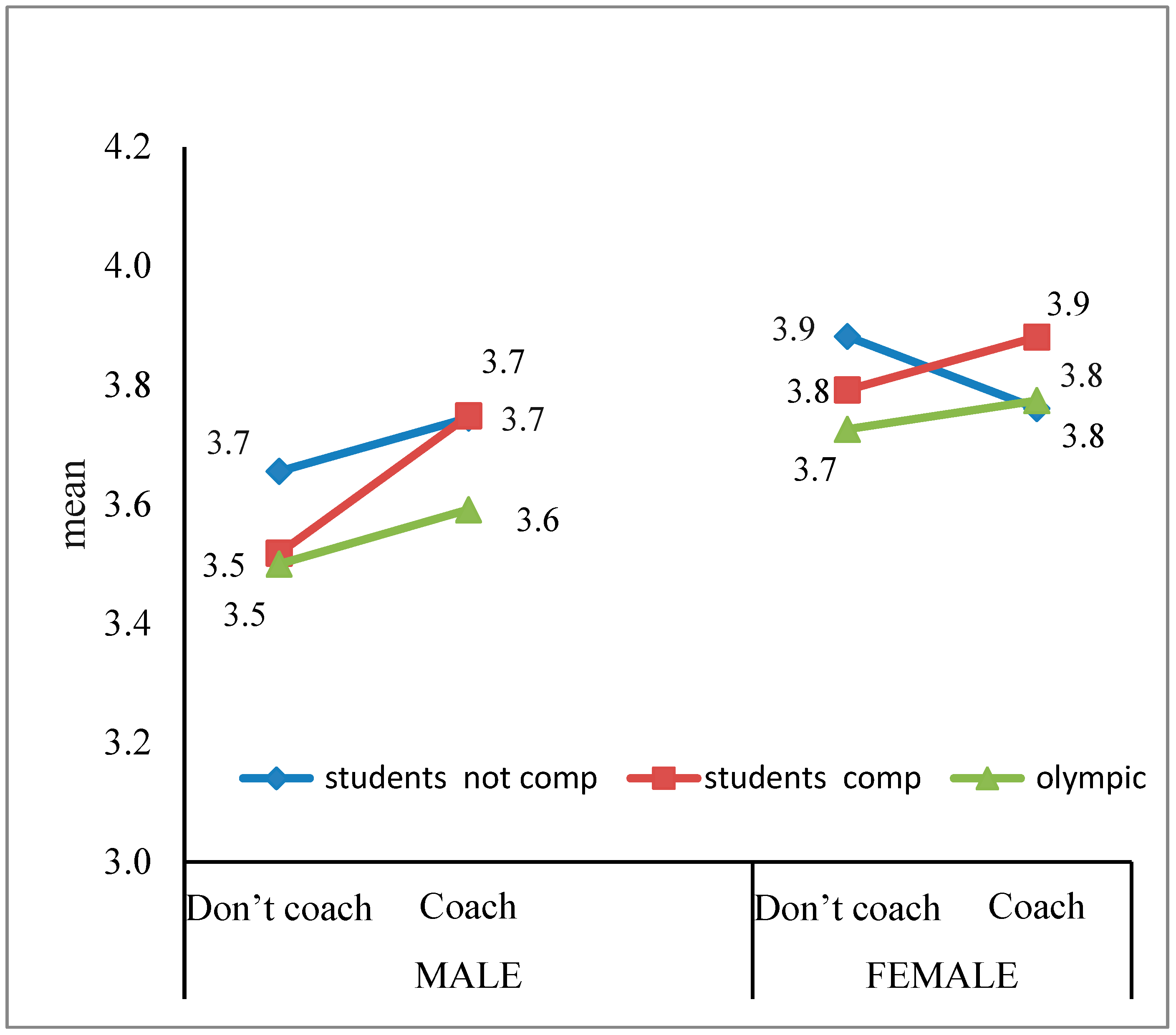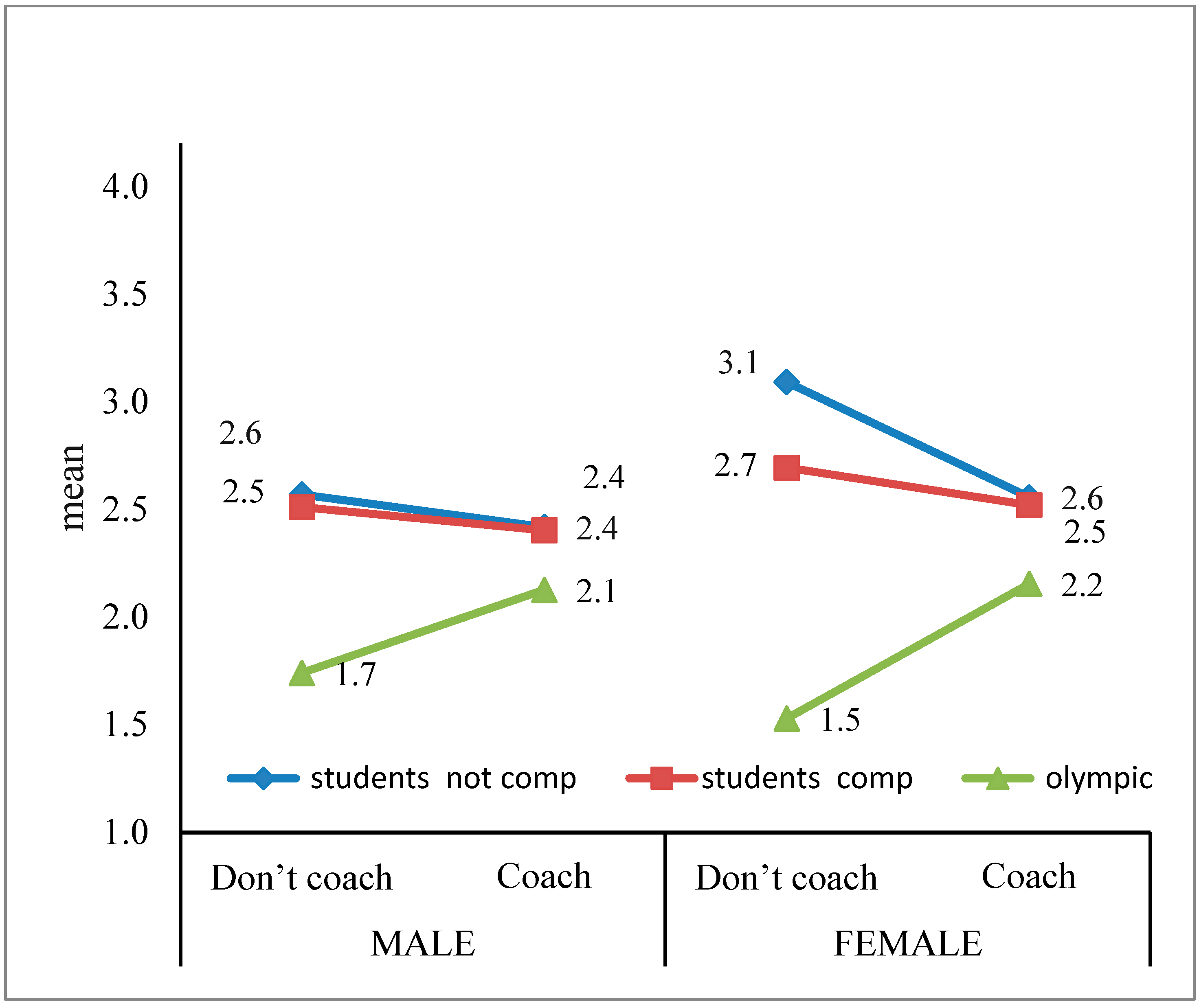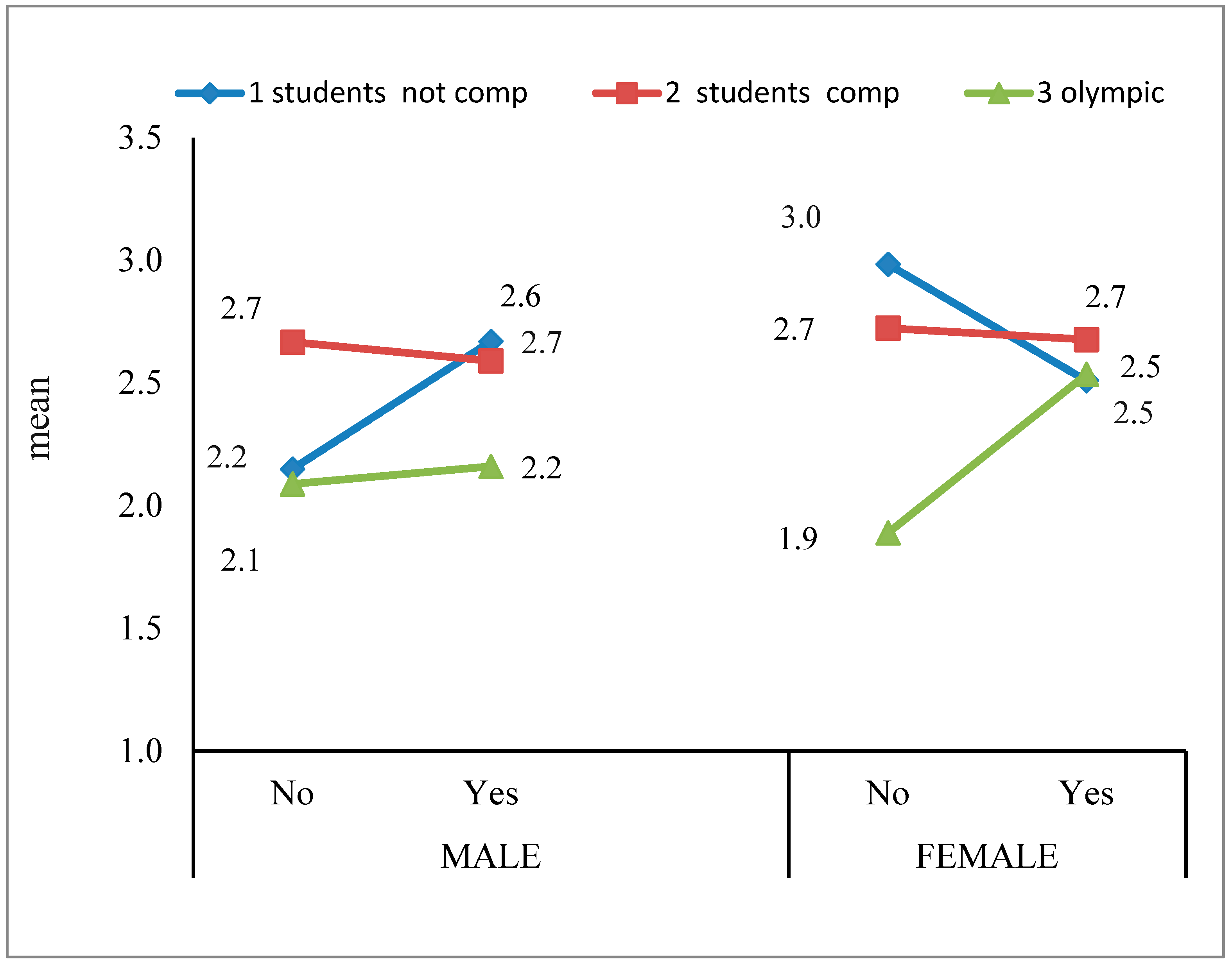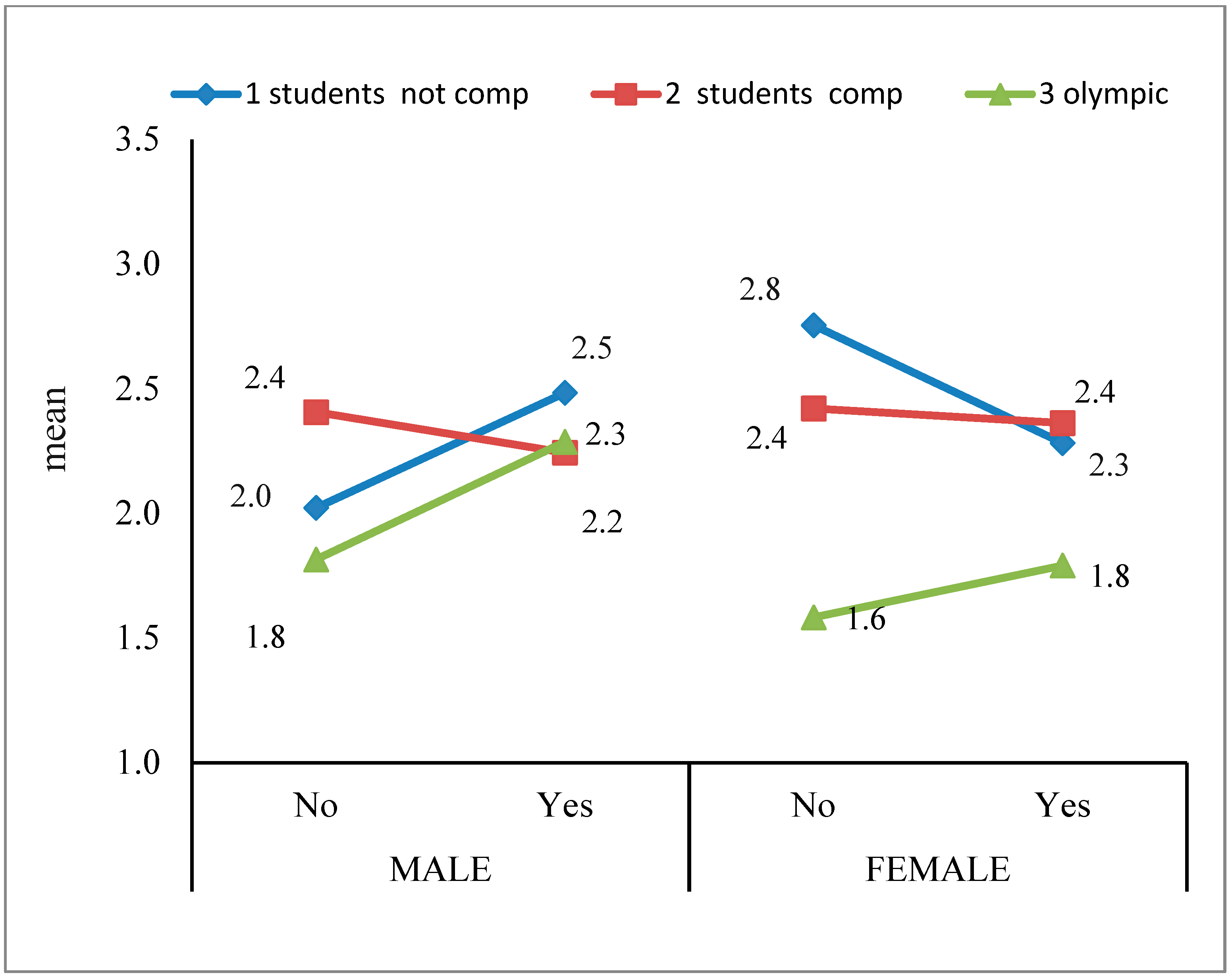The Meaning of Sexual Harassment in the Eye of the Beholder: 25 Years After the Enactment of Israel’s Prevention of Sexual Harassment Law
Abstract
1. Introduction
2. Methodology
2.1. Participants
2.2. Questionnaire
- (1)
- Severe harassment and exploitation, referring to overtly sexual or coercive verbal and physical behaviors (e.g., kissing, touching, sexual propositions);
- (2)
- Sexist behavior, reflecting stereotypical, gender-degrading comments or condescending expressions (e.g., affectionate nicknames, jokes about women);
- (3)
- Professional contact, describing ambiguous but work-related physical gestures (e.g., touching during instruction, congratulatory hugs);
- (4)
- Between concern and interest, which includes interpersonal gestures with uncertain intent (e.g., private invitations, asking about personal plans).
2.3. Procedure
2.4. Data Analysis
3. Results
4. Discussion
4.1. Gender Differences in Perception
4.2. Differences Across Levels of Sport
4.3. Coaches vs. Non-Coaches
4.4. Practical Implications and Future Directions
Author Contributions
Funding
Institutional Review Board Statement
Informed Consent Statement
Data Availability Statement
Conflicts of Interest
References
- Mohajan, H.K. Feminism and feminist grounded theory: A comprehensive research analysis. J. Econ. Dev. Environ. People 2022, 11, 45. [Google Scholar] [CrossRef]
- Ferguson, K.E. Feminist theory today. Annu. Rev. Political Sci. 2017, 20, 269–286. [Google Scholar] [CrossRef]
- Lorraine Radtke, H. Feminist theory in Feminism & Psychology [Part I]: Dealing with differences and negotiating the biological. Fem. Psychol. 2017, 27, 357–377. [Google Scholar] [CrossRef]
- Emerson, R.M. Power-dependence relations: Two experiments. Sociometry 1964, 27, 282–298. [Google Scholar] [CrossRef]
- Emerson, R.M. Power-dependence relations. In Power in Modern Societies; Routledge: Abingdon, UK, 2019; pp. 48–58. [Google Scholar]
- Avelino, F.; Wittmayer, J.M. Shifting power relations in sustainability transitions: A multi-actor perspective. J. Environ. Policy Plan. 2016, 18, 628–649. [Google Scholar] [CrossRef]
- Rodriguez, J.K.; Guenther, E.A.; Faiz, R. Feminist futures in gender-in-leadership research: Self-reflexive approximations to intersectional situatedness. Gend. Manag. Int. J. 2023, 38, 230–247. [Google Scholar] [CrossRef]
- Mountjoy, M.; Brackenridge, C.; Arrington, M.; Blauwet, C.; Carska-Sheppard, A.; Fasting, K.; Budgett, R. International Olympic Committee consensus statement: Harassment and abuse (non-accidental violence) in sport. Br. J. Sports Med. 2016, 50, 1019–1029. [Google Scholar] [CrossRef] [PubMed]
- Krieger, J.; Pieper, L.P. Athlete perceptions of governance-related issues to sexual abuse in sport. Soc. Sci. 2023, 12, 141. [Google Scholar] [CrossRef]
- Hershcovis, M.S.; Vranjes, I.; Berdahl, J.L.; Cortina, L.M. See no evil, hear no evil, speak no evil: Theorizing network silence around sexual harassment. J. Appl. Psychol. 2021, 106, 1834. [Google Scholar] [CrossRef]
- Guy, S.; Zach, S. The person who loves me the most is also the person who hurts me the most: Power relations between a single coach and an athlete from the athletes’ point of view. Spirit Sport (Ruach Ha’Sport) 2023, 9, 83–110. (In Hebrew) [Google Scholar]
- Fasting, K.; Sand, T.S.; Sisjord, M.K. Coach–athlete sexual relationships: Coaches’ opinions. Int. J. Sports Sci. Coach. 2018, 13, 463–470. [Google Scholar] [CrossRef]
- Zach, S.; Davidovitz, M.; Cohen, R. Comparative perceptions of sexual harassment among athletes across different competitive levels. Front. Sports Act. Living 2024, 6, 1468534. [Google Scholar] [CrossRef] [PubMed]
- Kol Zchut. Prevention of Sexual Harassment Law, 5758–1998—English Summary; Kol Zchut: Kefar Veradim, Israel, 2023; Available online: https://www.kolzchut.org.il/w/he/images/9/9f/%D7%AA%D7%A7%D7%A0%D7%95%D7%9F_%D7%94%D7%98%D7%A8%D7%93%D7%94_%D7%9E%D7%99%D7%A0%D7%99%D7%AA_%28%D7%90%D7%A0%D7%92%D7%9C%D7%99%D7%AA%29.pdf (accessed on 29 June 2025).
- Council of Europe & European Union. All In Plus: Promoting Greater Gender Equality in Sport—Gender Equality in Sport: Israel Factsheet; Council of Europe & European Union: Strasbourg, France, 2024; Available online: https://rm.coe.int/all-in-plus-israel-05022025/1680b420f0 (accessed on 29 June 2025).
- Feigin, N.; HaNegabi, R. Is it only sport? Perceptions and experiences of sexual harassment in sports. Dapim 1999, 30, 106–129. (In Hebrew) [Google Scholar]
- Volkwein, K.A.; Schnell, F.I.; Sherwood, D.; Livezey, A. Sexual harassment in sport: Perceptions and experiences of American female student-athletes. Int. Rev. Sociol. Sport 1997, 32, 283–295. [Google Scholar] [CrossRef]
- Ridgeway, C.L. Framed before we know it: How gender shapes social relations. Gend. Soc. 2009, 23, 145–160. [Google Scholar] [CrossRef]
- Bragagnolo, W.; Lezama, Y. Unveiling sextortion in sport: A global inquiry into the nexus of sexual violence, abuse of power, and corruption for enhanced safeguarding. Crime Law Soc. Change 2025, 83, 13. [Google Scholar] [CrossRef]
- Hoop, R.; Schyvinck, C.; Haerens, L.; Willem, A. Unravelling the process towards athlete harassment and abuse by sport coaches: An in-depth examination of the role of controlling coaching and normalization. Safe Sport Inspiration Days 2024, Abstracts. In Proceedings of the Safe Sport Inspiration Days 2024, Antwerp, Belgium, 27–28 November 2024. [Google Scholar]
- Alexandre, J.; Castro, C.; Gama, M.; Antunes, P. Perceptions of sexual abuse in sport: A qualitative study in the Portuguese sports community. Front. Sports Act. Living 2022, 4, 838480. [Google Scholar] [CrossRef]
- de Haan, D.; Norman, L. Mind the gap: The presence of capital and power in the female athlete–male-coach relationship within elite rowing. Sports Coach. Rev. 2020, 9, 95–118. [Google Scholar] [CrossRef]
- Fasting, K.; Brackenridge, C.; Knorre, N. Performance level and sexual harassment prevalence among female athletes in the Czech Republic. Women Sport Phys. Act. J. 2010, 19, 26–32. [Google Scholar] [CrossRef]
- Vertommen, T.; Schipper-van Veldhoven, N.; Wouters, K.; Kampen, J.K.; Brackenridge, C.; Rhind, D.J.; Van Den Eede, F. Interpersonal violence against children in sport in the Netherlands and Belgium. Child Abus. Negl. 2016, 51, 223–236. [Google Scholar] [CrossRef]
- Newman, T.J.; Santos, F.; Pierce, S.; Collins, K.; Mercier, V. Coach education and coach development within a contemporary social justice society: Implications for future research and potential pitfalls. Quest 2022, 74, 234–250. [Google Scholar] [CrossRef]
- Graham, L.C.; Blackett, A.D. ‘Coach, or female coach? And does it matter?’: An autoethnography of playing the gendered game over a twenty-year elite swim coaching career. Qual. Res. Sport Exerc. Health 2022, 14, 811–826. [Google Scholar] [CrossRef]
- Levi, H.; Wadey, R.; Bunsell, T.; Day, M.; Hays, K.; Lampard, P. Women in a man’s world: Coaching women in elite sport. J. Appl. Sport Psychol. 2023, 35, 571–597. [Google Scholar] [CrossRef]
- Zach, S.; Guy, S.; Ben-Yechezkel, R.; Grosman-Rimon, L. Clear yet crossed: Athletes retrospective reports of coach violence. Behav. Sci. 2024, 14, 486. [Google Scholar] [CrossRef]




| Questionnaire Items | Past n = 301 | Present n = 80 | |||||||||
|---|---|---|---|---|---|---|---|---|---|---|---|
| M | S.D | Not at All | To a Great Extent | M | S.D | Not at All | To a Great Extent | χ | p | ||
| Severe harassment and exploitation | 3.67 | 0.39 | 3.81 | 0.30 | 2.89t = | 0.03 | |||||
| 22 | Proposes sexual encounter and issues rewards, or threats for rejection | 0.00 | 90.00 | 3.92 | 0.27 | 0.00 | 92.41 | ||||
| 25 | Kisses an athlete on her mouth | 0.70 | 77.40 | 3.92 | 0.27 | 0.00 | 92.41 | 9.06 | 0.01 | ||
| 11 | Shows a sexual interest in the athlete | 2.30 | 78.70 | 3.88 | 0.40 | 0.00 | 90.00 | 5.81 | 0.05 | ||
| 12 | Proposes sexual encounter without rewards, or threats for rejection | 3.00 | 80.10 | 3.85 | 0.45 | 0.00 | 88.75 | 4.27 | 0.12 | ||
| 21 | Asks athlete about her sex life | 0.00 | 74.40 | 3.90 | 0.30 | 0.00 | 89.87 | 8.61 | 0.00 | ||
| 19 | Pinches athlete in behind | 0.00 | 71.10 | 3.92 | 0.27 | 0.00 | 92.41 | 15.37 | 0.00 | ||
| 16 | Stares at athlete’s breasts | 1.00 | 68.40 | 3.84 | 0.40 | 0.00 | 85.00 | 15.86 | 0.00 | ||
| 13 | Tells an athlete about his sex life | 2.70 | 74.80 | 3.78 | 0.64 | 0.00 | 85.00 | 4.72 | 0.09 | ||
| 27 | Caresses athlete | 1.00 | 61.50 | 3.61 | 0.56 | 0.00 | 64.56 | 0.96 | 0.62 | ||
| 17 | Gives an athlete a back/shoulder massage for fun | 4.30 | 41.50 | 3.38 | 0.88 | 0.00 | 56.25 | 7.84 | 0.02 | ||
| Between concern and interest | 2.52 | 0.77 | 2.73 | 0.65 | 2.2t = | 0.03 | |||||
| 4 | Invites an athlete to his home for a coffee | 16.30 | 17.30 | 2.47 | 1.12 | 11.39 | 22.78 | 2.01 | 0.37 | ||
| 6 | Invites the athlete for a dinner | 8.30 | 39.90 | 3.38 | 0.91 | 2.50 | 60.00 | 11.47 | 0.00 | ||
| 5 | Asks the athlete what does she do in her leisure time | 27.20 | 15.00 | 2.28 | 0.95 | 21.25 | 10.00 | 3.25 | 0.20 | ||
| 10 | Asks the athlete for her weekend plans | 17.60 | 28.90 | 2.80 | 0.99 | 12.50 | 27.50 | 1.53 | 0.47 | ||
| 14 | Invites the athlete for lunch in a local cafe | 20.60 | 14.30 | 2.73 | 0.94 | 8.86 | 21.52 | 7.01 | 0.03 | ||
| 1 | Invites an athlete to train at his home | 28.60 | 10.30 | 2.33 | 1.24 | 18.99 | 22.78 | 9.82 | 0.01 | ||
| Sexist behavior | 2.31 | 0.67 | 2.71 | 0.70 | 4.70t = | 0.00 | |||||
| 23 | Complements athlete on her looks | 17.90 | 6.30 | 3.15 | 0.82 | 2.53 | 39.24 | 64.31 | 0.00 | ||
| 26 | Makes derogatory remarks on women | 9.00 | 28.90 | 3.05 | 0.88 | 2.53 | 34.18 | 3.99 | 0.14 | ||
| 15 | Talks about what he likes to do in his free time | 41.20 | 5.00 | 2.26 | 1.01 | 23.08 | 14.10 | 13.84 | 0.00 | ||
| 18 | Calls the athlete by pet name (such as sweetie and honey) | 19.90 | 8.30 | 2.62 | 0.96 | 11.39 | 22.78 | 14.42 | 0.00 | ||
| 20 | Tells the athlete about his weekend plans | 23.90 | 13.30 | 2.41 | 0.91 | 13.92 | 15.19 | 3.66 | 0.16 | ||
| Professional contact | 1.91 | 0.61 | 2.48 | 0.57 | 7.53t = | 0.00 | |||||
| 8 | Places his hand on the athlete’s shoulder or arm when greeting her | 40.90 | 3.70 | 2.33 | 0.99 | 18.75 | 15.00 | 23.28 | 0.00 | ||
| 2 | Touches the athlete on her shoulder or hand while instructing her | 55.50 | 2.00 | 1.89 | 0.98 | 40.00 | 10.00 | 14.73 | 0.00 | ||
| 3 | Stands or sits close to the athlete during office conversations | 35.90 | 7.60 | 2.53 | 0.94 | 13.75 | 17.50 | 17.85 | 0.00 | ||
| 9 | Closes the door while talking in office | 12.00 | 31.90 | 3.69 | 0.54 | 0.00 | 72.73 | 44.80 | 0.00 | ||
| 7 | Kisses the athlete on her cheeks | 39.90 | 9.30 | 2.63 | 1.00 | 10.00 | 20.00 | 27.28 | 0.00 | ||
| 24 | Hugs athlete when winning a competition | 70.10 | 1.00 | 1.75 | 0.95 | 49.37 | 7.59 | 19.52 | 0.00 | ||
| Males | Females | ||||||||||
|---|---|---|---|---|---|---|---|---|---|---|---|
| Factors | STs Non-Co N = 32 | STs-Co N = 105 | Olympic Ath. N = 14 | STs-Non-Co N = 74 | STs-Co N = 96 | Olympic Ath. N = 39 | Gender (1355) | Comp. (2355) | Inter (2355) | ||
| 1 | M | 3.711 | 3.701 | 3.533 | 3.815 | 3.852 | 3.757 | F | 11.213 ** | 2.366 | 0.415 |
| S.D | 0.337 | 0.472 | 0.482 | 0.301 | 0.255 | 0.243 | η2 | 0.031 | 0.013 | 0.002 | |
| 2 | M | 2.475 | 2.245 | 1.879 | 2.795 | 2.576 | 1.930 | F | 3.203 | 14.896 ** | 0.610 |
| S.D | 0.674 | 0.764 | 0.755 | 0.716 | 0.688 | 0.774 | η | 0.009 | 0.078 | 0.003 | |
| 3 | M | 2.475 | 2.606 | 2.114 | 2.721 | 2.692 | 2.304 | F | 3.424 | 6.805 ** | 0.428 |
| S.D | 0.751 | 0.670 | 0.855 | 0.692 | 0.703 | 0.680 | η | 0.010 | 0.037 | 0.002 | |
| 4 | M | 2.310 | 2.277 | 1.983 | 2.493 | 2.381 | 1.716 | F | 0.007 | 13.495 ** | 2.158 |
| S.D | 0.557 | 0.669 | 0.653 | 0.590 | 0.546 | 0.451 | η | 0.000 | 0.071 | 0.012 | |
| Factors | Males | Females | |||||||||||
|---|---|---|---|---|---|---|---|---|---|---|---|---|---|
| Sport Level | STs Non-Co | STs-Co | Olympic Athletes | STs Non-Co | STs-Co | Olympic Athletes | |||||||
| Coach | Yes | No | Yes | No | Yes | No | Yes | No | Yes | No | Yes | No | |
| N | N = 12 | N = 20 | N = 22 | N = 84 | N = 9 | N = 5 | N = 33 | N = 41 | N = 31 | N = 65 | N = 14 | N = 25 | |
| 1 | M | 3.65 | 3.74 | 3.51 | 3.74 | 3.50 | 3.59 | 3.88 | 3.76 | 3.79 | 3.88 | 3.72 | 3.77 |
| S.D | 0.36 | 0.32 | 0.69 | 0.38 | 0.53 | 0.42 | 0.27 | 0.31 | 0.34 | 0.19 | 0.15 | 0.28 | |
| 2 | M | 2.56 | 2.41 | 2.51 | 2.40 | 1.74 | 2.12 | 3.09 | 2.55 | 2.69 | 2.52 | 1.52 | 2.15 |
| S.D | 0.77 | 0.62 | 0.68 | 0.78 | 0.60 | 1.00 | 0.60 | 0.71 | 0.69 | 0.68 | 0.61 | 0.77 | |
| 3 | M | 2.15 | 2.67 | 2.66 | 2.59 | 2.08 | 2.16 | 2.98 | 2.50 | 2.72 | 2.67 | 1.88 | 2.53 |
| S.D | 0.65 | 0.75 | 0.72 | 0.65 | 0.80 | 1.03 | 0.61 | 0.68 | 0.66 | 0.72 | 0.658 | 0.58 | |
| 4 | M | 2.02 | 2.48 | 2.40 | 2.24 | 1.81 | 2.28 | 2.75 | 2.28 | 2.42 | 2.36 | 1.58 | 1.79 |
| S.D | 0.35 | 0.59 | 0.72 | 0.65 | 0.60 | 0.69 | 0.43 | 0.61 | 0.46 | 0.58 | 0.41 | 0.46 | |
| 1 | 2 | 3 | 4 | |||||||||
|---|---|---|---|---|---|---|---|---|---|---|---|---|
| Source | F | Sig. | Partial Eta Squared | F | Sig. | Partial Eta Squared | F | Sig. | Partial Eta Squared | F | Sig. | Partial Eta Squared |
| Gender | 12.54 | 0.00 | 0.035 | 1.65 | 0.20 | 0.005 | 2.93 | 0.09 | 0.008 | 0.02 | 0.90 | 0.000 |
| Level of sport (participation) | 1.36 | 0.26 | 0.008 | 16.09 | 0.00 | 0.085 | 7.94 | 0.00 | 0.044 | 12.25 | 0.00 | 0.066 |
| Coaching | 2.04 | 0.15 | 0.006 | 0.01 | 0.94 | 0.000 | 1.21 | 0.27 | 0.003 | 0.84 | 0.36 | 0.002 |
| Gender × Sport participation | 0.40 | 0.67 | 0.002 | 1.18 | 0.31 | 0.007 | 1.07 | 0.35 | 0.006 | 3.89 | 0.02 | 0.022 |
| Gender × Coaching | 1.75 | 0.19 | 0.005 | 0.12 | 0.73 | 0.000 | 0.45 | 0.50 | 0.001 | 5.01 | 0.03 | 0.014 |
| Sport participation × Coaching | 1.71 | 0.18 | 0.010 | 4.68 | 0.01 | 0.026 | 1.42 | 0.24 | 0.008 | 2.31 | 0.10 | 0.013 |
| Gender × Sport Participation × Coaching | 0.19 | 0.83 | 0.001 | 0.69 | 0.50 | 0.004 | 5.59 | 0.00 | 0.031 | 5.51 | 0.00 | 0.031 |
Disclaimer/Publisher’s Note: The statements, opinions and data contained in all publications are solely those of the individual author(s) and contributor(s) and not of MDPI and/or the editor(s). MDPI and/or the editor(s) disclaim responsibility for any injury to people or property resulting from any ideas, methods, instructions or products referred to in the content. |
© 2025 by the authors. Licensee MDPI, Basel, Switzerland. This article is an open access article distributed under the terms and conditions of the Creative Commons Attribution (CC BY) license (https://creativecommons.org/licenses/by/4.0/).
Share and Cite
Zach, S.; Cohen, R.; Arnon, M. The Meaning of Sexual Harassment in the Eye of the Beholder: 25 Years After the Enactment of Israel’s Prevention of Sexual Harassment Law. Societies 2025, 15, 190. https://doi.org/10.3390/soc15070190
Zach S, Cohen R, Arnon M. The Meaning of Sexual Harassment in the Eye of the Beholder: 25 Years After the Enactment of Israel’s Prevention of Sexual Harassment Law. Societies. 2025; 15(7):190. https://doi.org/10.3390/soc15070190
Chicago/Turabian StyleZach, Sima, Rona Cohen, and Michal Arnon. 2025. "The Meaning of Sexual Harassment in the Eye of the Beholder: 25 Years After the Enactment of Israel’s Prevention of Sexual Harassment Law" Societies 15, no. 7: 190. https://doi.org/10.3390/soc15070190
APA StyleZach, S., Cohen, R., & Arnon, M. (2025). The Meaning of Sexual Harassment in the Eye of the Beholder: 25 Years After the Enactment of Israel’s Prevention of Sexual Harassment Law. Societies, 15(7), 190. https://doi.org/10.3390/soc15070190





